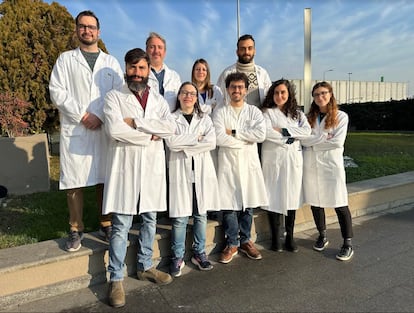A new strategy to cure disease in a single day, and forever: epigenetic silencing
A breakthrough experimental treatment has succeeded in permanently deactivating a bad cholesterol gene in mice, without modifying their DNA

A team of Italian researchers has reached a major scientific milestone, heralding a revolution in the field of medicine. The scientists have succeeded in silencing a gene associated with high cholesterol levels, without the need to modify DNA. In the experiment, which was conducted on mice, the effects of the gene silencing persisted for the entire year that the experiment lasted — a period equivalent to half an average human life. These results suggest that it may be possible to solve chronic health problems, permanently, and in a single day of treatment. The study was published this Wednesday in the journal Nature, a leading reference in the world of science.
DNA is like a book, with some 3 billion chemical letters, that provides instructions for the functioning of every cell. This immense text is divided into pages — the genes — which contain specific recipes for making the proteins necessary for life: the collagen in cartilage, the hemoglobin in blood, the antibodies that fight pathogens. One of these genes, PCSK9, contains guidelines for producing a protein associated with elevated levels of bad cholesterol. The U.S. company Verve Therapeutics announced on November 12 that it had edited the DNA of the liver cells of a dozen people with dangerous congenital hypercholesterolemia, inactivating their PCSK9 gene and succeeding in cutting cholesterol by half. This experimental gene therapy, called VERVE-101, was the first to use the revolutionary CRISPR gene-editing tools to modify DNA directly in a patient, not just in cells in a laboratory.
The new study has achieved something similar, but without altering the DNA. The Italian team, led by biotechnologist Angelo Lombardo of the San Raffaele Telethon Institute of Gene Therapy in Milan, has not, in other words, made genetic changes, but rather epigenetic ones. If we conceptualize DNA as words that convey instructions, epigenetic modifications are akin to adding chemical accent marks, with the capacity to alter the meaning of the message. Lombardo’s team has managed to silence a bad-cholesterol gene by adding small molecules to the DNA of liver cells. “This is the first published demonstration that a single treatment with epigenetic editors can produce a stable silencing of a gene,” he says.
According to Lombardo, “there are many diseases that can be treated with epigenetic editing.” He mentions other liver pathologies, such as hepatitis B, caused by a virus that embeds its genetic material in the human cell. “As for cancer, we ourselves, as well as other groups, are employing epigenetic editing to silence multiple genes in T lymphocytes [white blood cells that defend the human body against germs and disease], with the aim of making these cells fight tumors better,” Lombardo adds.
In 2021, the Italian biotechnologist and his American colleagues started a company, Chroma Medicine, with the aim of “revolutionizing the treatment of diseases” through epigenetic editing. The company, with headquarters in Boston and Milan, got off the ground with about 115 million euros in funding. Among its co-founders is the chemist David Liu, a Harvard University researcher who has transformed medicine with CRISPR genetic engineering tools, such as base editors — continuing with the textual metaphor, think of it as a kind of pencil with an eraser — capable of removing a single letter from DNA and replacing it with another. Verve Therapeutics used these sophisticated base editors to inactivate the bad cholesterol gene in the initial ten patients.
Angelo Lombardo argues that epigenetic editing has advantages over DNA modification. “It does not induce breaks in the genome, which can be toxic, and it can also be reversed with drugs or other epigenetic editing strategies that reactivate the silenced gene. So you have possible antidotes in case of adverse effects,” he says. Lombardo stresses that the therapy is still experimental and that scientists will need to confirm its immense potential as a treatment by testing the therapy on other animals, possibly in monkeys, but he believes that clinical trials in humans “will not take long.”
Epigenetics expert Manel Esteller, who was not involved in the study, applauds the research. “The interesting thing about this case is that it appears that these modifications are maintained over time and are even conserved when the liver cells divide,” he says. “The mechanisms of this persistence are not clear, but if the findings are validated in other animal experiments and then in human trials, it could mean that the therapy would be sufficient to treat a defect or excess of a gene with one single dose” Esteller, who serves as the director of the Josep Carreras Leukemia Research Institute in the Spanish town of Badalona, Barcelona, explains that there are currently nine epigenetic drugs approved for use in oncology, especially in the treatment of leukemias, lymphomas and soft tissue tumors. A month ago, Esteller’s team discovered “the factors that make it possible to predict whether or not epigenetic treatment will be effective in a patient.”
Spanish biologist Xurde Menéndez Caravia and his colleagues at the University of Texas Southwestern Medical Center used David Liu’s genetic “pencil” in mice a year ago to make subtle changes in the sequence of a gene linked to a multitude of common heart diseases. Menéndez Caravia says that “epigenetic silencing is an original and novel idea,” but could not have replaced the precision of the genetic pencil in his experiment. “One aspect to consider is off-target silencing, that is, the unwanted repression of non-PCSK9 genes. The authors report off-target silencing of several genes whose consequences are unknown. The repercussions this would have on liver cells should be explored in depth,” the biologist warns.
Sign up for our weekly newsletter to get more English-language news coverage from EL PAÍS USA Edition
Tu suscripción se está usando en otro dispositivo
¿Quieres añadir otro usuario a tu suscripción?
Si continúas leyendo en este dispositivo, no se podrá leer en el otro.
FlechaTu suscripción se está usando en otro dispositivo y solo puedes acceder a EL PAÍS desde un dispositivo a la vez.
Si quieres compartir tu cuenta, cambia tu suscripción a la modalidad Premium, así podrás añadir otro usuario. Cada uno accederá con su propia cuenta de email, lo que os permitirá personalizar vuestra experiencia en EL PAÍS.
¿Tienes una suscripción de empresa? Accede aquí para contratar más cuentas.
En el caso de no saber quién está usando tu cuenta, te recomendamos cambiar tu contraseña aquí.
Si decides continuar compartiendo tu cuenta, este mensaje se mostrará en tu dispositivo y en el de la otra persona que está usando tu cuenta de forma indefinida, afectando a tu experiencia de lectura. Puedes consultar aquí los términos y condiciones de la suscripción digital.
More information
Archived In
Últimas noticias
Most viewed
- Reinhard Genzel, Nobel laureate in physics: ‘One-minute videos will never give you the truth’
- Oona Chaplin: ‘I told James Cameron that I was living in a treehouse and starting a permaculture project with a friend’
- Pablo Escobar’s hippos: A serious environmental problem, 40 years on
- Why we lost the habit of sleeping in two segments and how that changed our sense of time
- The fall of a prolific science journal exposes the billion-dollar profits of scientific publishing











































